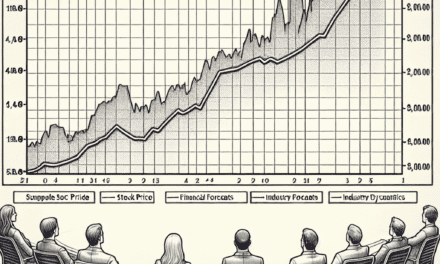“Citi Lowers Icon Price Target to $290: A Strategic Shift in Market Outlook.”
Introduction
Citi has revised its price target for Icon, lowering it from $300 to $290. This adjustment reflects changes in market conditions and company performance metrics, prompting analysts to reassess the stock’s valuation. The new target indicates a cautious outlook while still suggesting potential for growth in the company’s future prospects.
Citi’s Price Target Adjustment for Icon
Citi has recently made a notable adjustment to its price target for Icon, a prominent player in the biopharmaceutical sector. The investment bank has lowered its price target from $300 to $290, reflecting a more cautious outlook on the company’s future performance. This decision comes in the wake of various market dynamics and internal assessments that have prompted analysts to reevaluate their projections.
The reduction in the price target is significant, as it indicates a shift in sentiment regarding Icon’s growth trajectory. Analysts at Citi have cited several factors contributing to this adjustment. Primarily, there are concerns about the competitive landscape within the biopharmaceutical industry, which has become increasingly crowded. As new entrants emerge and existing companies ramp up their research and development efforts, the pressure on Icon to maintain its market position intensifies. Consequently, this heightened competition could impact the company’s ability to achieve its projected revenue growth.
Moreover, Citi’s analysts have pointed to recent developments in regulatory environments that may pose challenges for Icon. The biopharmaceutical sector is heavily influenced by regulatory approvals, and any delays or setbacks in this area can have a cascading effect on a company’s stock performance. In light of these considerations, Citi’s revised price target reflects a more tempered view of Icon’s potential to navigate these complexities successfully.
In addition to external factors, internal company performance metrics have also played a role in Citi’s decision. Recent earnings reports have shown mixed results, with some key performance indicators falling short of expectations. This has raised questions about the company’s operational efficiency and its ability to execute on strategic initiatives. As a result, analysts are adopting a more conservative stance, which is evident in the lowered price target.
Despite the adjustment, it is essential to recognize that Citi’s analysts still maintain a positive outlook on Icon’s long-term prospects. The company has a robust pipeline of products that, if successfully developed and brought to market, could significantly enhance its revenue streams. Furthermore, Icon’s commitment to innovation and its strategic partnerships position it well to capitalize on emerging opportunities within the biopharmaceutical landscape. Therefore, while the price target has been reduced, the underlying belief in the company’s potential remains intact.
Transitioning to the broader market context, it is crucial to consider how this adjustment fits within the overall investment climate. Investors are increasingly seeking clarity and stability in their portfolios, particularly in sectors as volatile as biopharmaceuticals. As such, adjustments like Citi’s can serve as valuable indicators for market participants, guiding their investment decisions. The reduction in price target may prompt some investors to reassess their positions in Icon, weighing the risks against the potential rewards.
In conclusion, Citi’s decision to lower its price target for Icon from $300 to $290 underscores the complexities and challenges facing the biopharmaceutical industry. While the adjustment reflects a more cautious outlook, it does not diminish the long-term potential that Icon possesses. As the company navigates a competitive landscape and addresses internal performance metrics, investors will be closely monitoring developments to gauge the effectiveness of its strategies. Ultimately, this price target adjustment serves as a reminder of the dynamic nature of the market and the importance of staying informed in an ever-evolving investment environment.
Implications of the New $290 Price Target
Citi’s recent decision to reduce the price target for Icon from $300 to $290 carries significant implications for investors and stakeholders alike. This adjustment reflects a recalibration of expectations regarding the company’s future performance, influenced by various market dynamics and internal assessments. As analysts strive to provide accurate forecasts, such revisions often signal shifts in the underlying fundamentals of the business or broader economic conditions that could impact its trajectory.
The reduction in price target suggests that Citi anticipates a more cautious outlook for Icon, which may stem from a variety of factors, including competitive pressures, changes in consumer demand, or macroeconomic trends. Investors should consider how these elements could affect Icon’s revenue streams and profitability moving forward. For instance, if the company faces increased competition in its sector, it may struggle to maintain its market share, thereby impacting its growth potential. Consequently, a lower price target may indicate that analysts foresee a more challenging environment for the company, prompting a reassessment of its valuation.
Moreover, the adjustment to the price target may also reflect broader market sentiments. In an environment characterized by volatility and uncertainty, investors often become more risk-averse, leading to a reevaluation of asset values. This shift in sentiment can be particularly pronounced in sectors that are sensitive to economic cycles. As such, the new price target of $290 may serve as a barometer for investor confidence in Icon’s ability to navigate these challenges effectively.
In addition to market conditions, the reduction in price target may also be influenced by Icon’s recent performance metrics. If the company has reported lower-than-expected earnings or has provided guidance that falls short of analyst projections, this could prompt a reassessment of its growth prospects. Investors should closely monitor the company’s upcoming earnings reports and any strategic initiatives that management may announce, as these factors will play a crucial role in shaping future expectations.
Furthermore, the implications of the new price target extend beyond immediate financial considerations. For existing shareholders, a lower price target may necessitate a reevaluation of their investment strategies. Some investors may choose to hold their positions, betting on a potential rebound in the company’s fortunes, while others may opt to divest in light of the revised outlook. This decision-making process is often influenced by individual risk tolerance and investment horizons, underscoring the importance of aligning one’s portfolio with personal financial goals.
On a broader scale, the adjustment in price target could also impact market perceptions of the sector in which Icon operates. If investors interpret Citi’s revision as a signal of underlying weakness within the industry, it may lead to a broader sell-off of stocks in that sector, further exacerbating the situation. Conversely, if Icon manages to outperform expectations despite the lowered target, it could restore confidence and potentially lead to a rebound in stock prices.
In conclusion, Citi’s reduction of Icon’s price target to $290 from $300 carries multifaceted implications for investors and the market at large. As stakeholders navigate this revised outlook, it is essential to consider the various factors influencing the company’s performance and the broader economic landscape. By staying informed and adaptable, investors can better position themselves to respond to the evolving dynamics surrounding Icon and its industry.
Market Reactions to Citi’s Downgrade
In a recent development that has captured the attention of investors and market analysts alike, Citi has announced a reduction in its price target for Icon, lowering it from $300 to $290. This adjustment has sparked a variety of reactions across the financial landscape, reflecting the complexities of market dynamics and investor sentiment. The decision by Citi, a prominent player in the financial services sector, is indicative of broader trends and considerations that are influencing stock valuations in the current economic climate.
The downgrade comes amid a backdrop of fluctuating market conditions, where investors are increasingly cautious about the potential for economic headwinds. As inflationary pressures persist and interest rates remain elevated, companies across various sectors are grappling with the implications of these macroeconomic factors. In this context, Citi’s revised price target for Icon suggests a more conservative outlook, which may resonate with investors who are seeking to mitigate risk in their portfolios. The reduction in the price target could be interpreted as a signal that Citi anticipates challenges ahead for Icon, prompting a reevaluation of its growth prospects.
Market reactions to such downgrades are often immediate and pronounced. Following the announcement, Icon’s stock experienced a notable shift, reflecting the sentiment of investors who may have been caught off guard by the news. The decline in stock price can be attributed to a combination of factors, including the broader market’s response to economic indicators and the specific implications of Citi’s analysis. Investors often react swiftly to changes in analyst ratings, as these assessments can significantly influence trading behavior and market sentiment.
Moreover, the downgrade has prompted discussions among analysts and market commentators regarding the underlying reasons for Citi’s decision. Some experts suggest that the reduction in the price target may be linked to concerns about Icon’s competitive positioning within its industry. As companies navigate an increasingly crowded marketplace, the ability to maintain market share and drive growth becomes paramount. Consequently, investors are keenly attuned to any signals that may indicate a shift in a company’s trajectory, making Citi’s downgrade particularly noteworthy.
In addition to the immediate impact on Icon’s stock price, the downgrade has broader implications for investor confidence in the sector. When a major financial institution like Citi revises its outlook, it can set off a chain reaction, influencing other analysts and investors to reassess their positions. This phenomenon underscores the interconnectedness of the financial markets, where the actions of one entity can reverberate throughout the ecosystem. As a result, the downgrade may lead to increased scrutiny of other companies within the same sector, as investors seek to identify potential vulnerabilities.
As the market continues to digest Citi’s revised price target for Icon, it is essential for investors to remain vigilant and informed. The landscape is characterized by uncertainty, and the ability to adapt to changing conditions is crucial for navigating the complexities of the market. In this environment, understanding the nuances of analyst ratings and their implications can provide valuable insights for making informed investment decisions. Ultimately, Citi’s decision to lower its price target serves as a reminder of the ever-evolving nature of the financial markets and the importance of staying attuned to the factors that drive stock performance.
Analysis of Icon’s Financial Performance
Citi’s recent decision to reduce the price target for Icon from $300 to $290 reflects a nuanced analysis of the company’s financial performance and market conditions. This adjustment, while seemingly minor, underscores the complexities inherent in evaluating a company that operates in a rapidly evolving sector. To understand the implications of this price target revision, it is essential to delve into the various factors influencing Icon’s financial landscape.
Firstly, Icon has demonstrated a robust revenue growth trajectory over the past few quarters, driven by its innovative product offerings and strategic market positioning. However, despite this growth, analysts have noted a deceleration in the pace of new customer acquisitions, which raises questions about the sustainability of its revenue streams. This slowdown can be attributed to increased competition in the industry, as well as shifting consumer preferences that necessitate a reevaluation of marketing strategies. Consequently, Citi’s analysts have taken a more cautious stance, reflecting concerns that the company may face challenges in maintaining its previous growth rates.
Moreover, the cost structure of Icon has come under scrutiny. While the company has invested heavily in research and development to foster innovation, these expenditures have led to a tightening of profit margins. As a result, Citi’s analysts have adjusted their forecasts to account for potential increases in operational costs, which could further impact profitability. This shift in focus from revenue growth to cost management highlights the delicate balance that Icon must strike to ensure long-term financial health.
In addition to internal factors, external market conditions also play a significant role in shaping Icon’s financial performance. The broader economic environment, characterized by fluctuating interest rates and inflationary pressures, has created a challenging backdrop for many companies. For Icon, these macroeconomic factors could lead to increased borrowing costs and reduced consumer spending, both of which could adversely affect its financial results. As such, Citi’s revised price target reflects a more conservative outlook, taking into account the potential headwinds that may arise from these external pressures.
Furthermore, investor sentiment has shifted in recent months, with a growing emphasis on companies that demonstrate resilience in the face of uncertainty. This shift has prompted a reevaluation of growth expectations across the sector, leading to a more cautious approach among analysts. Citi’s decision to lower the price target for Icon is indicative of this broader trend, as investors seek to align their portfolios with companies that exhibit strong fundamentals and adaptability.
In conclusion, Citi’s reduction of Icon’s price target from $300 to $290 serves as a reflection of the company’s current financial performance and the challenges it faces in a competitive landscape. While Icon has shown commendable revenue growth, concerns regarding customer acquisition, cost management, and external economic factors have prompted a more tempered outlook. As the company navigates these complexities, it will be crucial for management to implement strategies that not only address immediate challenges but also position Icon for sustainable long-term growth. Ultimately, the revised price target encapsulates a cautious yet informed perspective on Icon’s future, emphasizing the importance of adaptability in an ever-changing market.
Factors Influencing Citi’s Price Target Change
Citi’s recent decision to reduce its price target for Icon from $300 to $290 reflects a nuanced analysis of various factors influencing the company’s market position and future performance. This adjustment is not merely a reaction to short-term market fluctuations but rather a comprehensive evaluation of the underlying dynamics that could impact Icon’s growth trajectory. One of the primary factors contributing to this revision is the evolving landscape of the industry in which Icon operates. As competition intensifies, companies are increasingly required to innovate and adapt to maintain their market share. Citi’s analysts have noted that while Icon has historically been a strong player, the emergence of new competitors and alternative solutions could pose challenges to its growth.
Moreover, macroeconomic conditions play a significant role in shaping market expectations. The current economic environment, characterized by fluctuating interest rates and inflationary pressures, has led to a cautious outlook among investors. In this context, Citi’s analysts have taken a closer look at how these broader economic factors might affect Icon’s revenue streams and profitability. For instance, rising costs of raw materials and labor could squeeze margins, prompting a reassessment of the company’s financial outlook. Additionally, the potential for economic slowdowns in key markets may further complicate Icon’s ability to achieve its growth targets.
Another critical aspect influencing Citi’s price target change is the company’s recent performance metrics. While Icon has demonstrated resilience in certain areas, there have been signs of deceleration in growth rates that warrant attention. Citi’s analysts have scrutinized quarterly earnings reports and other financial indicators, identifying trends that suggest a need for a more conservative approach to future projections. This careful analysis underscores the importance of aligning price targets with realistic expectations based on current performance rather than overly optimistic forecasts.
Furthermore, regulatory changes and compliance requirements can significantly impact a company’s operational landscape. In recent months, there have been discussions around potential regulatory shifts that could affect Icon’s business model. Citi’s analysts have factored in the possibility of increased compliance costs and operational adjustments that may arise from these changes. Such considerations are crucial, as they can influence not only short-term profitability but also long-term strategic planning.
In addition to these external factors, internal company dynamics also play a pivotal role in shaping Citi’s revised price target. Leadership changes, shifts in corporate strategy, and investment in research and development are all elements that can affect investor confidence and market perception. Citi’s analysts have closely monitored these internal developments, recognizing that a strong leadership team and a clear strategic vision are essential for navigating the complexities of the market.
In conclusion, Citi’s decision to lower Icon’s price target from $300 to $290 is a reflection of a multifaceted analysis that considers industry competition, macroeconomic conditions, recent performance metrics, regulatory changes, and internal company dynamics. By taking a holistic view of these factors, Citi aims to provide a more accurate and realistic assessment of Icon’s potential in the evolving market landscape. This adjustment serves as a reminder of the importance of continuous evaluation in the ever-changing world of finance and investment, where adaptability and foresight are key to success.
Investor Sentiment Following the Price Target Reduction
In the ever-evolving landscape of financial markets, investor sentiment plays a crucial role in shaping stock performance and overall market dynamics. Recently, Citi’s decision to reduce its price target for Icon plc from $300 to $290 has sparked a wave of reactions among investors and analysts alike. This adjustment, while seemingly minor in percentage terms, reflects a broader reassessment of the company’s growth prospects and market conditions, which can significantly influence investor behavior.
The reduction in the price target can be attributed to various factors, including changes in market conditions, competitive pressures, and shifts in the regulatory environment. As investors digest this news, it is essential to consider how such adjustments can impact overall sentiment. A price target reduction often signals to the market that analysts may have lowered their expectations for a company’s future performance. Consequently, this can lead to a more cautious approach among investors, who may begin to reevaluate their positions in the stock.
Moreover, the timing of Citi’s announcement coincides with a period of heightened volatility in the markets, which can exacerbate investor reactions. In an environment where uncertainty looms large, even minor adjustments in price targets can lead to significant shifts in sentiment. Investors may become more risk-averse, opting to reassess their portfolios and consider reallocating their investments to sectors or companies perceived as more stable or promising. This cautious sentiment can create a ripple effect, influencing not only Icon’s stock but also the broader market as investors seek to mitigate potential losses.
Additionally, the reduction in the price target may prompt discussions among analysts and investors regarding the underlying fundamentals of Icon. While Citi’s adjustment reflects a more conservative outlook, it also opens the door for deeper analysis of the company’s financial health, growth trajectory, and competitive positioning. Investors may begin to scrutinize Icon’s recent performance metrics, market share, and strategic initiatives to determine whether the revised target is justified or overly pessimistic. This analytical approach can lead to a more informed investor base, ultimately contributing to a more stable market environment.
Furthermore, the reaction to Citi’s price target reduction may also be influenced by broader market trends and economic indicators. For instance, if the overall market is experiencing a downturn, investors may be more inclined to react negatively to any news that suggests a company is facing challenges. Conversely, in a bullish market, the same news might be interpreted with a more optimistic lens, as investors may believe that the company can still achieve growth despite the revised target. Thus, the context in which the price target reduction occurs is critical in shaping investor sentiment.
In conclusion, Citi’s decision to lower its price target for Icon plc from $300 to $290 serves as a pivotal moment for investor sentiment. As market participants grapple with the implications of this adjustment, it is clear that such changes can have far-reaching effects on how investors perceive the company’s future prospects. The interplay between analyst expectations, market conditions, and investor behavior underscores the complexity of financial markets, where even minor adjustments can lead to significant shifts in sentiment and strategy. As investors navigate this landscape, a careful analysis of the factors at play will be essential in making informed decisions moving forward.
Future Outlook for Icon Stock Post-Downgrade
In the wake of Citi’s recent decision to lower its price target for Icon stock from $300 to $290, investors and analysts alike are closely examining the implications of this downgrade for the company’s future outlook. This adjustment reflects a recalibration of expectations based on various market dynamics and internal assessments of Icon’s performance. As such, it is essential to consider the factors that may influence the stock’s trajectory moving forward.
Firstly, the reduction in the price target suggests that Citi anticipates a more cautious growth trajectory for Icon. This could be attributed to a variety of reasons, including potential headwinds in the broader market, shifts in consumer demand, or changes in regulatory environments that may impact the company’s operations. Investors should remain vigilant about these external factors, as they can significantly affect the company’s ability to meet its financial targets. Moreover, the downgrade may also signal a need for Icon to reassess its strategic initiatives to ensure sustained growth in a competitive landscape.
Furthermore, it is important to recognize that a price target adjustment does not inherently indicate a negative outlook for the company. Instead, it may reflect a more tempered view that accounts for current market realities. For instance, while Icon has demonstrated resilience in its core business segments, the evolving economic conditions could necessitate a more conservative approach to growth projections. Consequently, investors may want to consider the long-term fundamentals of the company, including its market position, product offerings, and operational efficiencies, as these factors will ultimately drive its performance.
In addition, the reaction of the market to Citi’s downgrade will be crucial in shaping the future of Icon stock. If investors perceive the adjustment as a signal of underlying weaknesses, it could lead to increased volatility in the stock price. Conversely, if the market views the downgrade as a prudent measure that allows for more realistic expectations, it may stabilize the stock and provide a foundation for future growth. Therefore, monitoring market sentiment and investor behavior in the wake of this announcement will be essential for understanding the stock’s trajectory.
Moreover, Icon’s management team will play a pivotal role in navigating the challenges posed by this downgrade. Effective communication regarding the company’s strategic direction and operational performance will be vital in maintaining investor confidence. If management can articulate a clear vision for growth and demonstrate the ability to adapt to changing market conditions, it may mitigate some of the negative sentiment associated with the price target reduction. This proactive approach could also enhance the company’s reputation among investors, potentially leading to a more favorable assessment of its long-term prospects.
In conclusion, while Citi’s decision to lower the price target for Icon stock from $300 to $290 may raise concerns among investors, it also presents an opportunity for a deeper analysis of the company’s future outlook. By considering the broader market dynamics, the company’s strategic initiatives, and the potential reactions from both the market and management, stakeholders can gain a more nuanced understanding of what lies ahead for Icon. Ultimately, the ability of the company to adapt and respond to these challenges will be critical in determining its success in the coming months and years. As such, investors should remain informed and engaged as they navigate this evolving landscape.
Q&A
1. **Question:** What is the new price target set by Citi for Icon?
**Answer:** $290.
2. **Question:** What was the previous price target for Icon before the reduction?
**Answer:** $300.
3. **Question:** Which financial institution made the adjustment to Icon’s price target?
**Answer:** Citi.
4. **Question:** What is the reason for Citi’s reduction in the price target for Icon?
**Answer:** Specific reasons were not provided in the question.
5. **Question:** How much has Citi reduced the price target for Icon?
**Answer:** By $10.
6. **Question:** Is the new price target for Icon above or below the previous target?
**Answer:** Below.
7. **Question:** What does a price target reduction typically indicate about a company’s expected performance?
**Answer:** It may indicate a less optimistic outlook on the company’s future performance.
Conclusion
Citi’s reduction of the price target for Icon from $300 to $290 reflects a reassessment of the company’s growth prospects and market conditions, indicating a more cautious outlook while still maintaining a positive stance on its overall performance.




